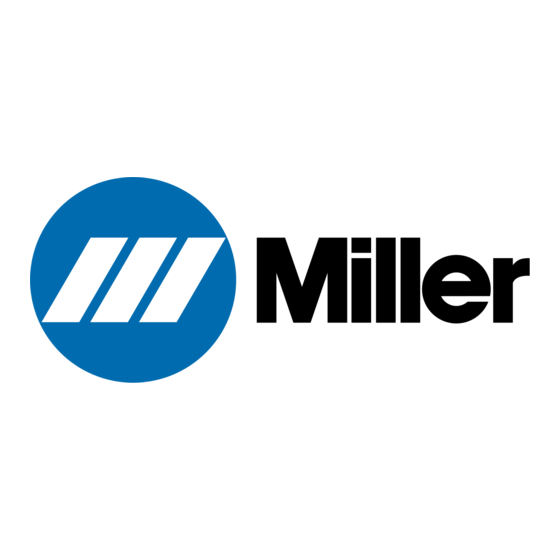
Table of Contents
Advertisement
Quick Links
Visit our website at
www.MillerWelds.com
Guidelines For
Shielded Metal Arc
Welding (SMAW)
WARNING
This document contains general information about the topics discussed herein.
This document is not an application manual and does not contain a complete
statement of all factors pertaining to those topics.
This installation, operation, and maintenance of arc welding equipment and the
employment of procedures described in this document should be conducted
only by qualified persons in accordance with applicable codes, safe practices,
and manufacturer's instructions.
Always be certain that work areas are clean and safe and that proper ventilation
is used. Misuse of equipment, and failure to observe applicable codes and safe
practices, can result in serious personal injury and property damage.
155 095 A
July 2005
Processes
Stick (SMAW) Welding
ARC WELDING can be hazardous.
www.manaraa.com
Advertisement
Table of Contents

Summarization of Contents
Section 1: Safety Precautions
Symbol Usage
Explanation of warning symbols used throughout the manual to indicate hazards.
Arc Welding Hazards
Identification and avoidance of potential dangers associated with arc welding processes.
Additional Symbols for Installation, Operation, and Maintenance
Symbols related to installation, operation, and maintenance hazards of welding equipment.
California Proposition 65 Warnings
State-specific warnings regarding chemicals in welding fumes and engine exhaust.
Principal Safety Standards
List of key safety standards and organizations relevant to welding practices.
EMF Information
Information on electromagnetic fields (EMF) and their potential effects during welding.
Section 3: Shielded Metal Arc Welding (SMAW) Procedure
Typical Stick Welding Set-Up
Guidance on the standard setup for performing stick (SMAW) welding operations.
Electrode and Amperage Selection Chart
Chart for selecting appropriate electrodes and amperage ranges for various welding tasks.
Striking an Arc: Scratch Start Technique
Method for initiating an arc by scratching the electrode against the workpiece.
Striking an Arc: Tapping Technique
Method for initiating an arc by tapping the electrode against the workpiece.
Positioning Electrode Holder
Correct angles and positioning for the electrode holder during welding.
Electrode Movement During Welding
Techniques for moving the electrode, including stringer and weave beads.
Conditions Affecting Weld Bead Shape
Factors like electrode angle, arc length, and travel speed that influence weld bead appearance.
Poor Weld Bead Characteristics
Visual examples and descriptions of common defects in weld beads.
Good Weld Bead Characteristics
Visual examples and descriptions of desirable weld bead qualities.
Typical Weld Joints
Illustrations of common weld joint types in different welding positions.
Welding Butt Joints
Procedures and types for making butt welds, including preparation and techniques.
Welding Tee Joints
Techniques for creating fillet welds in tee joint configurations.
Welding Lap Joints
Procedures for making lap joints using single or multi-layer fillet welds.
Welding Horizontal Beads and Butt Joints
Specific techniques for performing horizontal welding on beads and butt joints.
Welding Vertical Beads and Butt Joints
Methods for welding vertical beads and butt joints, including upward and downward techniques.
Welding Vertical Tee Joints and Lap Joints
Techniques for welding vertical tee and lap joints, emphasizing weaving motion.
Welding Overhead Butt Joints and Tee Joints
Advanced techniques for performing overhead welding on butt and tee joints.
Weld Test
Methods for testing the quality and integrity of completed welds.
Section 4: Welding Troubleshooting
Porosity
Identification, causes, and corrective actions for porosity in weld metal.
Excessive Spatter
Causes and solutions for excessive scattering of molten metal particles during welding.
Incomplete Fusion
Causes and corrective actions for weld metal failing to fuse properly with base metal.
Lack Of Penetration
Causes and solutions for shallow fusion between weld metal and base metal.
Excessive Penetration
Causes and corrective actions for weld metal melting through the base metal.
Burn-Through
Causes and solutions for weld metal melting completely through the base metal, creating holes.
Waviness Of Bead
Causes and corrective actions for weld metal that is not parallel or covering the joint.
Distortion
Causes and corrective actions for metal movement due to weld contraction.













Need help?
Do you have a question about the SMAW and is the answer not in the manual?
Questions and answers